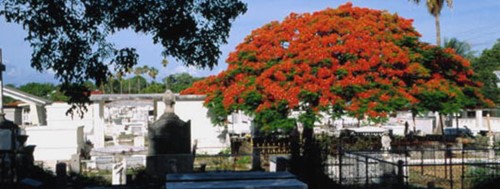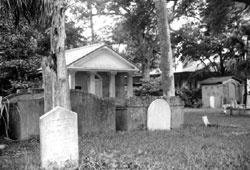What are the applicable laws and regulations?
Statutes and Rules Related to Historic and Abandoned Cemeteries, and to Unmarked Human Remains

The beginning point for proper treatment and protection of human burials is state law. In Florida, a number of statutes address authorities and responsibilities concerning cemeteries, graves, and human remains. These laws reflect society's strong commitment to respecting and protecting the final resting places of all people regardless of culture, religion, race, gender, or length of time since burial. All human remains are afforded equal protection under the law.
In simple terms, it is illegal to willfully and knowingly disturb human remains. See Section 872.02, Florida Statutes, for the exact language. It is also illegal to disturb memorials such as fences, tombstones, markers, and even vegetation associated with a burial. There are very narrow exceptions for cemetery operators and for persons acting under the direction of the Division of Historical Resources. The law does not provide exceptions for private property owners or for family or community or tribal representatives.
It is also illegal to deal in dead bodies, that is, to buy, sell, or possess for the purpose of buying or selling. See Section 872.01, Florida Statutes, for the exact language. The only exception is for medical education or research at an institution of higher learning. A more specific prohibition is in Chapter 873, Florida Statutes, concerning the sale of human organs or tissue including bone. This statute may apply in the case of American Indian human remains such as skulls and bones that are sometimes bought or sold by artifact collectors.
Florida law allows the moving of buried human remains by a licensed funeral director with a valid burial transit permit. See Section 497.384, Florida Statutes, for the exact language concerning disinterment, transportation and reinterment of human remains. Occasionally, graves are moved from inactive or abandoned cemeteries, or prior to construction of public works projects like roads, when avoidance is not possible. Moving graves is often controversial, and typically involves obtaining permission from descendants. Contact a licensed funeral director for more information about the possibility of moving graves. Neither the medical examiners nor the State Archaeologist have authority or responsibility to "clear" a proposed project that may disturb human remains, or to move unmarked graves.
 There are literally thousands of abandoned cemeteries in Florida, many of them unknown and forgotten as old homesteads are subdivided and sold off, cemetery operators go out of business, churches are moved, and new property owners are unaware of old burying grounds. In Section 497.284, Florida Statutes, Florida law authorizes a county or municipality to maintain and secure an abandoned cemetery or one that has not been maintained for more than six months. Private funds may be solicited and spent on such maintenance, and such efforts are exempt from civil liabilities or penalties connected with damages to the property being maintained. Finally, the county or municipality may sue the owner of the property to recover costs.
There are literally thousands of abandoned cemeteries in Florida, many of them unknown and forgotten as old homesteads are subdivided and sold off, cemetery operators go out of business, churches are moved, and new property owners are unaware of old burying grounds. In Section 497.284, Florida Statutes, Florida law authorizes a county or municipality to maintain and secure an abandoned cemetery or one that has not been maintained for more than six months. Private funds may be solicited and spent on such maintenance, and such efforts are exempt from civil liabilities or penalties connected with damages to the property being maintained. Finally, the county or municipality may sue the owner of the property to recover costs.
Maintaining cemeteries that are no longer active is a widespread problem throughout the state. A review by the Task Force on Abandoned and Neglected Cemeteries appointed by the Legislature in 1998 determined that some counties had more than 100 such cemeteries, and that thousands probably remain undocumented and uncared for in the state. The most successful efforts to rehabilitate and care for abandoned and neglected cemeteries depend on community organization and volunteer effort. Remember that many older cemeteries are important historic resources, and that special care is required to prevent damage to stones, ironwork, vegetation and other elements. See the section on Maintaining Historic Cemeteries before planning or undertaking any cleanup or restoration. Several case studies have been summarized to show what others have done. Often, it is necessary to form some sort of organization if none exists in your community; genealogists, historic preservationists, and other civic groups are often important in creating and continuing such efforts. A number of local organizations and other resources have been listed that might be willing to help.
As land changes hands, and as family and community ties to a particular piece of land are lost, it is not uncommon that a new landowner unknowingly restricts access to a burial ground. Florida law provides certain rights of access to cemeteries. See Section 704.08, Florida Statutes, for exact language. The statute says that relatives and descendants shall have an easement to enter and leave a cemetery at reasonable times and in a reasonable manner, and that the land owner may designate the easement. If the cemetery is not being maintained, the relatives and descendants may request the owner to provide reasonable maintenance, and if the owner fails or refuses, the relatives and descendants have the right to maintain the cemetery.
Sometimes property owners will refuse to grant an easement or even access to legitimate descendants and relatives of a person buried in a cemetery . In such cases, it is best to refer the matter to a law enforcement agency such as the sheriff's office, or possibly to elected officials, and ask that a proper easement be provided as the law requires. Contact information for law enforcement agencies is maintained by the Florida Attorney General's Office, or you can check the front pages of your telephone directory. It helps to document your communication by following a telephone conversation with a letter.
The laws protecting human burials and human remains are not selective. While we mostly think of traditional cemeteries with headstones and special plantings as final resting places, there are other kinds of burial sites. Before Europeans came to Florida some five centuries ago, our state was home to hundreds of generations of American Indian people. The Timucua, the Apalachee, the Calusa, and many tribes whose names are unknown, followed very specific burial practices. Many people were interred in burial mounds and temple mounds that still exist on the landscape today. Some of these sites are included in parks and preserves in public ownership, but many more exist on private land. In the mid-1980s Florida's cemetery law was revised to directly address the protection and respectful treatment of American Indian burial sites, as well as all other burials not in marked cemeteries. Section 872.02, Florida Statutes, was amended to specifically include burial mounds and earthen or shell monuments containing human skeletal remains or associated burial artifacts. Section 872.05, Florida Statutes, was added to ensure that proper steps were taken when unmarked human remains were encountered.
The procedures to be followed when unmarked human remains are discovered or disturbed begin with an important requirement-notifying local law enforcement. Here is the exact language from 872.05(3)(a):
"Any person who knows or has reason to know that an unmarked human burial is being unlawfully disturbed, destroyed, defaced, mutilated, removed, excavated, or exposed shall immediately notify the local law enforcement agency with jurisdiction in the area where the unmarked human burial is located."
This first step is critical. It starts a process that can offer protection to the burial site; it involves officials with experience in identifying human remains; it represents a series of procedures that modern Indian tribes, medical examiners, archaeologists, and others have agreed to follow; and it results in a final disposition of the remains after appropriate consultation and deliberation. If you ever find human remains, or bones that you think might be human, perhaps while digging or during construction, or as a result of erosion, do not remove or disturb them. Their location and situation will be important in determining where they came from and whether there are additional remains. Secure the area as well as you can and contact a local law enforcement agency immediately. Failure to notify law enforcement is a second degree misdemeanor.
The second important point about encountering possible human remains is that "all activity that may disturb the unmarked human burial shall cease immediately." Do not dig further, do not remove the remains, do not collect any artifacts, do not disturb the soil containing the remains. Once you have notified local law enforcement, who will likely contact the medical examiner, be prepared to meet them and explain what happened. The procedures for determining what will happen to the remains are set forth in the statute. Do not take it upon yourself to give someone permission to remove or disturb remains or associated artifacts, other than a law enforcement officer, the medical examiner, or an archaeologist representing the Florida Division of Historical Resources.

